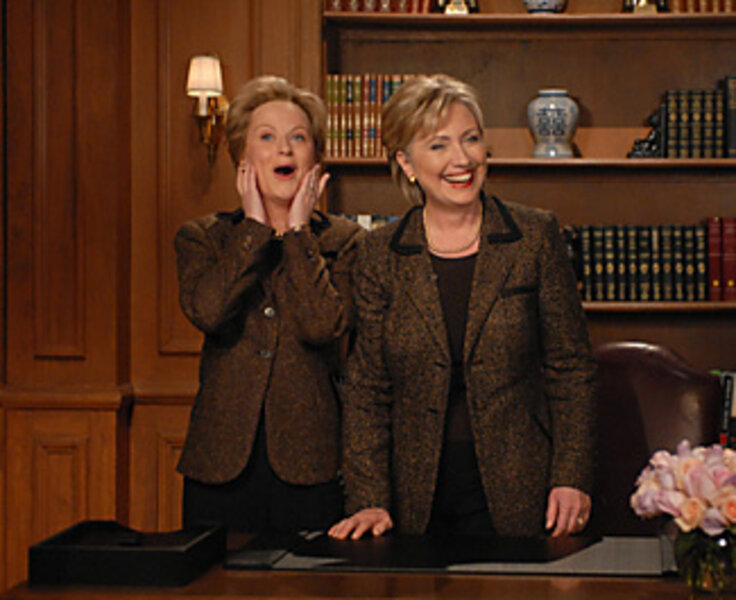Comic 'news' a force in '08 campaign
Loading...
| New York
Barack Obama seemed truly disappointed. On his campaign plane this week he told reporters, "I didn't expect that you guys would bite on that."
"That" refers to weeks of complaints by Sen. Hillary Rodham Clinton's campaign that the media were giving the Illinois senator a fairly free ride.
In fact, the media didn't "bite" right away. But after two "Saturday Night Live" skits satirizing the press corps as fawning over Mr. Obama – even ensuring that the actor playing him was comfortable during a debate – a raft of not-so-favorable headlines surfaced about the Illinois senator.
The relationship between the press and the politicians it covers inevitably becomes an issue in every campaign. But the shift in the news tone and coverage following the SNL Democratic debate skit points to how powerful the faux, comic news is becoming as a media critic and political force. That's particularly so because the expansion of broadband Internet now allows most Americans to replay almost any video clip they want.
"The least you can say is that Saturday Night Live's timing was exquisite – that it raised an issue that had been percolating out there," says Mark Jurkowitz of the Project for Excellence in Journalism (PEJ), which monitors press coverage of the campaign. "By any objective measure of press coverage, it did change and fairly abruptly."
In its index of campaign coverage, the PEJ found that in the week before the March 4 primaries in Texas and Ohio, Obama generated "the highest level of coverage for any candidate in 2008." Sixty-nine percent of the campaign news focused on him.
Much of it scrutinized Obama's legislative record in the Illinois statehouse, his ties to an indicted Chicago developer who was also a donor, and a flap over the North American Free Trade Agreement. In the case of NAFTA, the media reported that Obama's campaign couldn't get its message straight about whether or not it had assured Canadian officials that Obama's opposition to the trade agreement was just political grandstanding.
About the same time, the PEJ report notes the media started producing several self-reflective critiques with headlines such as: "Are the media giving Obama a free ride?"
Mr. Jurkowitz is quick to note that several factors could have led to the change in coverage. For one, since no other primaries were held in the week leading up to the "do or die" contests in Ohio and Texas Tuesday, the media didn't have any victories to parse.
"In almost any story of any serious magnitude, there's always a point at which the media's behavior becomes the story – briefly," says Jurkowitz. "Part of it was while sitting around waiting for 'crucial Tuesday' there was time to get introspective and to actually act on the perception that there was media bias...."
But there are indications that the SNL debate satire may have at least played a role in amplifying the perception of media bias.
A poll released Thursday by the Pew Research Center found that 58 percent of respondents felt the media coverage of Obama was fair, 28 percent felt that it was too easy, and 8 percent felt that media coverage was too tough. In comparison, 58 percent of people reported the coverage of Senator Clinton was fair, 19 percent said it was too easy, and 18 percent said it was too tough.
"So a small portion of the public judged that they'd been too tough on her and too easy on him," says Andrew Kohut, president of the Pew Research Center. "But the prevailing view of most people is: pretty much fair."
This isn't the first time an SNL skit helped amplify perceptions of a candidate or campaign. In 2000, SNL satirized Al Gore in his debate performance as pompous and boring to devastating effect.
Mr. Kohut says the skit can be viewed as one of the turning points in that presidential campaign. "This is not unprecedented. What happens is that these comedy shows can capture a sense of the candidates and the political scene in a way that's very accessible and connects with them on a humorous level and makes a point," he says.
The PEJ's Jurkowitz coined a new term to describe SNL's recent political parody: advocacy infotainment. "It was humorous, it was funny, and it was in keeping with everything they do, but in some ways it was a form of advocacy infotainment," says Jurkowitz.
Now that digital broadband has expanded to 70 percent of American households, the impact of advocacy infotainment is growing. "The impact of these moments is beyond the numbers of people that see them because they're constantly accessible to 70 percent of the population," says Kohut.
And politicians, like Clinton, use them in their campaigns. Indeed, during the Democratic debate Feb. 26, the New York senator referenced the SNL skit that parodied the way the media treated Obama. She was booed for doing it.
"But the media covering her comments and the re-airing of the skit on all of the national networks and all of the cable news [outlets] did help her and call attention to potential media bias," says Jennifer Lawless, a political scientist at Brown University in Providence, R.I.
Some experts also note that the perceptions of media bias are often a product of the ideological bent of the person who perceives it. "Partisans on both sides can view the very same thing and view it as biased against themselves," says Diana Mutz, a professor of political science and communications at the University of Pennsylvania. "So it's hard to prove evidence of bias one way or another, but in terms of political psychology, it is very effective to point to the media."





